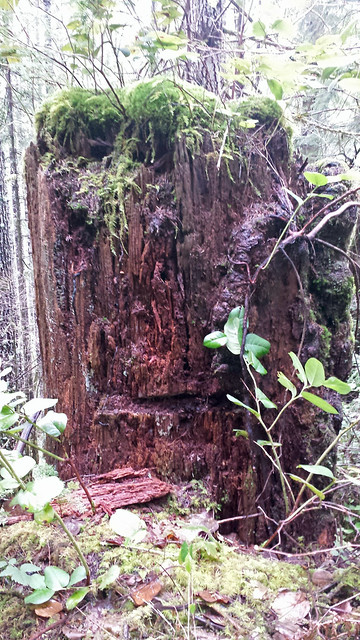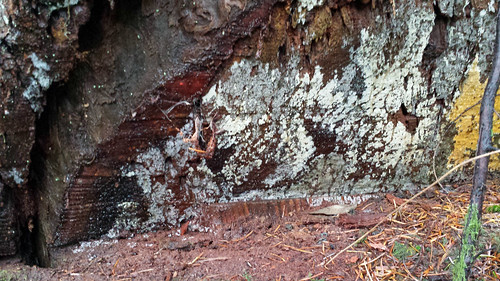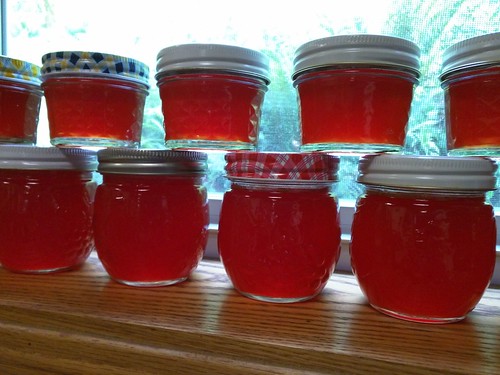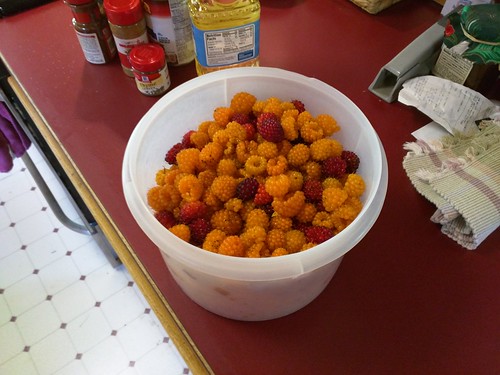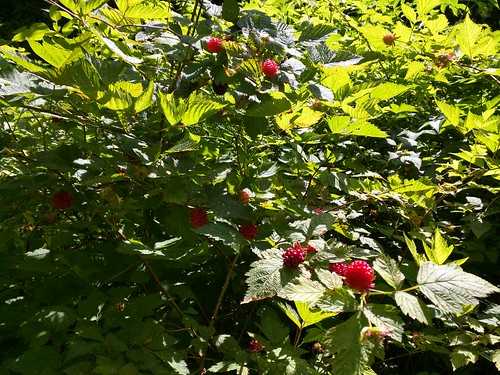Near Ye Olde Homestead lie many acres of forestland that were harvested about 70 years ago. Unlike today, where saplings are planted within a year after harvest, the old standard was to leave a few adult trees to re-seed the area naturally. You can still spot these parents because they're significantly larger and scragglier than their children. You can also still find many old stumps with a springboard notch still visible on the downhill side. Chainsaws were still not very common back then, so handsawing was still a thing. This generally meant two man teams; one on the ground, and one on a springboard shoved into a hasty notch on the downhill side.
Searching for springboard notches while hiking is now a classic PacNW pasttime.
I ran across this extra special stump during a Chritmas hike. It must have been a bitch for those poor loggers back in the day: they tried really hard to cut it closer to the ground, with four saw marks (note how ragged the saw marks are, too, showing that it was a hand saw, not a chainsaw),
before they gave up and cut six feet higher up the trunk. (That's the notch from the springboard they eventually put in).
There's also signs of what I think are healing in the bark. It lived as 'living stump" for at least a few years before finally succumbing completely to rot. (Now home to numberous invertebrates, mosses, lichens, and a robust salal plant.) Nearly every one of these old stumps is a nurse log. Huckleberry and hemlock love them especially.
Monday, September 26, 2016
Sunday, September 25, 2016
Salmonberry Jelly
Salmonberry is native to the Pacific Northwest and is very important to native americans all up and down the coast, from what's now Alaska, to what's now Northern California. It hasn't been domesticated, so this is only available by knowing a good picking spot (and having permission to pick there).
I also feel obligated to balance the extreme fruit-bias in our culture by informing everyone that the entire plant is edible. The fresh spring sprouts can be eaten raw or steamed.
The berries can be tricky. It's hard to tell when they're ripe because they come in such a wide array of colors (pale orange to dark red).
They have inconsistent (and most people say bland) flavor; birds and bears eat them before you can get them; and they tend to grow near stinging nettles and devils club.
(All of these are the same level of ripeness, from bushes a few feet apart)
They have inconsistent (and most people say bland) flavor; birds and bears eat them before you can get them; and they tend to grow near stinging nettles and devils club.
(me standing in front of a a nine-foot-tall nettle while picking)
But they're very juicy and I'm lucky to have a good spot on private land that no one else but the birds are using. My first trip to the patch was Memorial Day weekend. I got a decent amount, but the picking was better when I returned two weeks later.
For making the jelly, I got tips from this awesome blog, but I did a couple things different. I definitely agree with her that I would never make salmonberry jam - the seeds are ridiculous. (She's also in a much harsher environment than me. Our Oregon salmonberries grow ten feet tall).
I froze the berries, then cooked them and mashed them up, then dumped them in cheesecloth to get the juice out. (I can't stop myself from squeezing the cheesecloth to get juice out. That's supposed to make the juice cloudy, but I didn't see a big problem.)
I froze the berries, then cooked them and mashed them up, then dumped them in cheesecloth to get the juice out. (I can't stop myself from squeezing the cheesecloth to get juice out. That's supposed to make the juice cloudy, but I didn't see a big problem.)
RECIPE
4.5 cups of Salmonberry juice
7 cups of white sugar
1 package powdered SureJell
Yield: 9 cups of jelly, packaged in six 8oz jars, and five 4oz jars, and some extra I ate on toast right away.
I see a 4oz jar of Alaskan salmonberry jelly is selling on Amazon for six bucks, I should get on that.
Yield: 9 cups of jelly, packaged in six 8oz jars, and five 4oz jars, and some extra I ate on toast right away.
I see a 4oz jar of Alaskan salmonberry jelly is selling on Amazon for six bucks, I should get on that.

This was my first time tasting salmonberry anything (except fresh). It's very good. Reminiscent of raspberry (go figure), but it's own unique flavor.
Pojar, Jim and MacKinnon, Andy, ed. Plants of the Pacific Northwest Coast, Revised, Lone Pine, 2004
Subscribe to:
Posts (Atom)
